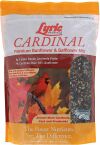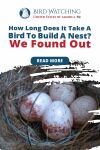
What’s this Post about?
Having the gorgeous, ruby red cardinals in our backyards is surely a mesmerizing treat. One of the most desirable backyard birds, the Northern Cardinals add a spectacular touch to backyards with their stunning plumages and cheerful melodious songs.
Fortunately, attracting the wonderful birds to your yard is not complex at all. You can expect to see them in your yard throughout the year.
You just need to delve deep to study the species closely and adapt a few Cardinal-friendly landscaping and feeding strategies to catch frequent glimpses of the cardinals from your window.
Cardinals prefer to nest in shrub thickets and their best choices include dogwood, hawthorn, clematis, and grapevine plantings. They do not nest in birdhouses and if you want to attract them to build a nest, provide nesting materials including grass clippings, pine needles, and small twigs.

What do Northern Cardinals look like?
Medium-sized, stout birds, the Northern Cardinals are bright red in color sporting a sharp red crest on their heads. Almost 9 inches in size, the Cardinal has a large, long tail with a short and sturdy bill.
The conspicuously brilliant red birds are hard to resist when you see them perched on a tree, singing their sweet whistling songs.

Relatively larger than the female, the male has a stunning, crimson red plumage with a black face mask and throat. The female on the other hand lacks the flamboyancy of its male.
With a grayish-brown plumage overall, there is a slight tinge of red on the wings, crest, and tail of the less showy female cardinal.
Attracting Cardinals to your Yard and Encouraging Nesting!
To get the breathtaking view of the beautiful birds in your yard, and to encourage them to nest either in or near your yard, all you need to do is create a welcoming environment for the shy yet stunning species.
Keep reading to explore the simple and effective strategies you can use to attract the Northern Cardinals to your yard!

Quite prevalent in the central areas of the cities, the cardinals visit backyards often.
Typically attracted to bird feeders in the yard, it is safe to claim that cardinals aren’t picky eaters at all. They land onto any bird feeders around, but they do have some special preferences.
We’ve got several tips that you can use to welcome the gorgeous cardinals to your yard and make sure they hang around there for longer!
1. Selecting the Right Bird Feeder
The optimal feeders for cardinals are the hopper and platform feeders.
Choosing the right feeder for the cardinals to have a good meal in your yard is essential. Placing small feeders or tube feeders for the relatively larger - medium-sized cardinals - isn’t a viable choice.
Since cardinals are heavier than many small birds, the feeders you place in your backyard should be strong and sturdy, providing ample space for the bird to perch, making sure they do not stumble.

Standing feeders are the most adept feeders for cardinals rather than hanging ones as they provide more support to the bird.
The optimal kind of feeders that enable the cardinals to feed comfortably are hopper or platform feeders.
These feeders give more room for the cardinals to land and perch easily. Explore the Perky-Pet 8LB Squirrel-Be-Gone II Feeder for cardinals.
Perky-Pet 8lb Squirrel-Be-Gone II Feeder Home with Chimney
Weight-activated seed protection covers ports under a squirrel’s weight
In the case when you’re using a hanging feeder, do not forget to place a mesh net, tray, or platform underneath to provide additional support to the bird.
Pro-Tip!
Do not let your bird feeders stay empty even for a bit. Regardless of what season it is, cardinals are usually the first to land in the yard in the early morning and the last to feed on your feeders at dusk. If they come to an empty feeder, they might be deterred to visit next time, as they search for more reliable food supplies.
To increase the chances of cardinals landing in your yard, keep these effective tips in mind.
- If you have a large backyard, add feeders at multiple locations, all of them filled with the cardinal’s favorite feeds.
This will help to avoid too many birds clustering into one feeder. Having more options nearby, they can conveniently feed in your yard.
- Where you place your cardinal feeder can be a make-or-break point for the arrivals of cardinals. There is less likelihood of cardinals to land on feeders placed in the middle of the yards. Instead, try placing them near shrubs and trees which act as a protective fortress for the cardinals.
They need to ensure they are free from any predatory threats before landing on the feeder. You’ll note how the tiny red birds would land on to feed their favorite foods when placed in locations they deem secure.
Warning!
The low-lying bushes and shrubs can also be a perfect spot for predators to hide. Make sure you don’t scatter too many seeds near these low-lying plantations allowing predators like cats to attack your birds.
2. The Right Feast for Cardinals
If you closely observe the beak of the cardinal, your birding proficiency might let you know that these thick, sturdy beaks are specialized to eat seeds, adept to crack open hard seed shells.
There are a multitude of bird seeds that you can fill the cardinal feeder with.
Since the bird is not too finicky about what is in the feeder, it feeds on black oil sunflower, cracked corn, Nyjer seeds, mealworms, peanuts, safflower, striped sunflower, among the many.

Knowing the preferences of the cardinal and providing it with a secure feeding platform, you can easily attract the Cardinal to your backyard.
You can place any one or a combination of these seeds in the cardinal’s feeder for the bird to have a feast.
For a perfect blend of the cardinal favorite seed mixes, try the Lyric 2647467 Cardinal Premium Sunflower and Safflower Wild Bird Mix
Lyric 2647467 Cardinal Premium Sunflower and Safflower Wild Bird Mix
The pack contains larger seeds which cardinals and other big billed birds prefer and has 70% sunflower seeds
Pro-Tip
Disperse a few seeds on the ground below the new feeders. Being surrounded by dense shrubs and greenery nearby, the cardinals feel a sense of protection. Cardinals flying high in the sky can also spot those seeds and would grace your feeder with their beautiful presence.
Seeds are not the only food that cardinals eat. These all-year-round, non-migratory birds like to add an assortment of foods to their diets.
Fruits also contribute to their diet, so it is a good idea to grow several fruit-bearing plants in your garden.
Seeing blueberry bushes, hackberry plantations, mulberry trees among the many other berries will surely attract Cardinals to your yard.
Keep in mind that cardinals like to forage on the ground, so finding the juicy berries on the low-lying shrubs can be an added perk for the cardinals.
If you want to treat the cardinals, place the many different kinds of fruits in the cardinal feeder. Any fresh fruit such as apple slices, grapes or would work.
Fun Fact
Cardinals are merely attracted to the seeds of the fruits only. They'll dig their stout beaks into the fruit, throwing the flesh and pulp aside and feed on the seeds. For this reason, fruits with larger seeds are preferred.
Did You Know?
The stunning red plumage that the cardinals flash around is the result of the bright red berries that they eat. The carotenoid pigments found in the red fruit cause the male cardinal to grow bright red feathers. It flaunts its gorgeous colors to attract its mates.
So now you know the right seeds and fruits that will help attract the bird to your yard.
3. Feeding the Baby Cardinals
The cardinals primarily feed their nestlings with insects such as caterpillars. These soft-bodied insects provide the babies with the right nutrients to grow.
During the breeding season, the major proportion of the diet of adult cardinals also comprises insects such as caterpillars and mealworms.

Attracting butterflies to your garden would be a great idea! For this, we recommend planting beds of butterfly host plants.
You can grow plants like aster, dogbane, goldenrod, milkweed, lupine among many others, to attract the butterflies - and indirectly - attract cardinals.
4. Offering a Water Source
Another essential element that cardinals look for is a source of water. By placing a water source nearby, you can satiate their desire to drink water.
Like many birds, cardinals not only drink the water but enjoy bathing in it and splashing around. This means there are high chances the cardinals would return to your feeder the next time.

Simply just putting water in a container may not be sufficient. Here are a few tips to make your water source attractive for the cardinals.
- Add one or two pieces of sticks to the birdbath. When the bird immerses itself in the water to drink and bathe in it, these slight seldom touches give it a soothing feeling.
This sensation of relaxation and comfort would surely bring the cardinal back to your yards!
- The all-year-round birds are more enticed by running sources of water. In the coolest winter months, much of the water in the yard tends to freeze. Spotting this running and dripping water makes your yard a resourceful one.
Pro-Tip
Use a heated birdbath to prevent the water from freezing and continue providing a freshwater source for the birds.
-
It is a good idea to place your birdbaths on the ground as the cardinals feel quite comfortable drinking water on ground baths.
-
Make sure you clean and add fresh water to the birdbath every day. Cardinals don’t like water with ample bacteria and algae growth or tons of mosquito eggs around. They might not visit this water bath again, so be careful.
Try getting a slightly deeper bath that is suitable for the medium-sized cardinal to float in. Read our post to understand some easy steps to help you set up your birdbath easily.
5 Easy Steps to Install a Bird Bath: Security, Position, Height, and More Tips!
Install a birdbath today and make your lawn, a bird’s gorgeous looking, favorite rest spot. Read more about this garden accessory now!
5. Offering the Right Nesting Material
Create a cardinal-friendly habitat in your yard by planting thick and dense greenery, bushes, and shrubs which serve as perfect nesting sites for cardinals.
Adding layers of these twiggy shrubs, leaves, and grass to your backyard provides a hospitable shelter for cardinals. So, if you’re lucky, they might choose to build their nests here.
You might set up elegant birdhouses in your yard in the hope that the cardinals might choose to nest in it.
Cardinals however would turn down your offer as they prefer to build their dainty cup-shaped nests among the branches of the trees.
If the cardinals don’t build their nests in your backyard, you might want them to dwell somewhere nearby.
For this, you need to give the birds a bulge by offering the right nesting material. It’s pretty basic - simply supply the basic nest-building elements.

Provide pieces of dog fur, pine needles, grass blades, twigs, strings and hang them on their platform feeders or an empty suet feeder.
The birds will cheerfully accept these materials and probably end up building their own nest nearby.
6. Providing Protection and Shelter
Planting evergreen trees and shrubs are the key to providing a safe shelter for the shy cardinals.
Shy in nature, the cardinals are pretty private birds, so they wouldn’t want to build their nests or seek shelter in open spaces. They prefer to stay concealed, perhaps to hide their flamboyant selves from the predators.
The cardinals thereby seek protection in the dense shrubs and trees. Finding thick greenery and layered plantations in your yard can attract the cardinals to camouflage themselves in the dense foliage.
Grow an array of large and small trees, shrubs, perennials, and grass to provide lots of cover to the birds.
Pro-Tip!
Add plantations of box elder, eastern red cedar, roses, and nannyberry to your yard to provide cover and dense greenery to attract the cardinals.
7. Ensure There Are No Reflective Surfaces Around!
These territorial cardinals are quite belligerent when it comes to protecting their territory from other birds. They exhibit extreme aggressiveness if some other birds try to intrude in their territory.
If they find their reflections in a window, car mirror, or on the floor, they will feel threatened by it and begin to attack it.
These rigorous fights with their reflections can last for days, adding to the stress levels of the cardinals, and proving injurious.
To make your yard welcoming for cardinals, avoid any such surfaces that cause agitation to the bird. If there are any shiny surfaces, glaring windows, or car mirrors around, cover them to avoid such encounters.
Enjoying a Year-round View of the Cardinals!

Unlike many other birds, the cardinals are non-migratory birds, so they wouldn’t fly too far off places in the winters.
To keep cardinals around your yard, you have to make arrangements to provide resources to the bird throughout the year, in hope that they nest near as well.
Using all of the above strategies, host a nesting pair of cardinals. Make sure you fulfill all the needs of the bird so that it stays with you.
Constructing their nests quite low, usually 6-8 feet above the ground, these birds begin to build their nests in the early days of spring, making a dainty cup-shaped structure to dwell on their nestlings.
After raising their first breed, the cardinals choose another location to build a new nest. These birds raise several broods in a year, and surprisingly, do not reuse their nests.
Hear the sweet pairs of cardinals singing from the higher branches of the tree. Their tunes are especially mesmerizing during the breeding season so keep looking for them as they soothe your ears with their cheerful songs.
Keep Reading!
It’s a thrilling experience to enjoy the stunning songbirds brace your yard with their presence every day - and even more - build their nests in your plantations.
All you need to do is provide them with the right snacks in the right feeder, give them a reliable source of water to quench their thirst and a densely planted shelter with covert nesting sites, and enjoy the red cardinals flitting around in your yards!
How about adding some more flash of red color in your backyard? Read through our blog to learn more about these brilliant redheaded birds that frequently pay a visit to your backyard.
13 Astounding Birds with Red Heads With Pictures! (Backyard Friendly)
Wondering what type of red-headed bird just fluttered by you in your backyard? It’s not as easy to figure out as you’d think. There are quite a few!

By David A. Swanson
Bird Watching USA
My name is David and I'm the the founder of Bird Watching USA! I started Bird Watching with My father-in-law many years ago, and I've become an addict to watching these beautiful creatures. I've learnt so much over about bird watching over the years that I want to share with the world everything I know about them!

David A. Swanson
Bird Watching USA
My name is David and I'm the the founder of Bird Watching USA! I started Bird Watching with My father-in-law many years ago, and I've become an addict to watching these beautiful creatures. I've learnt so much over about bird watching over the years that I want to share with the world everything I know about them!












